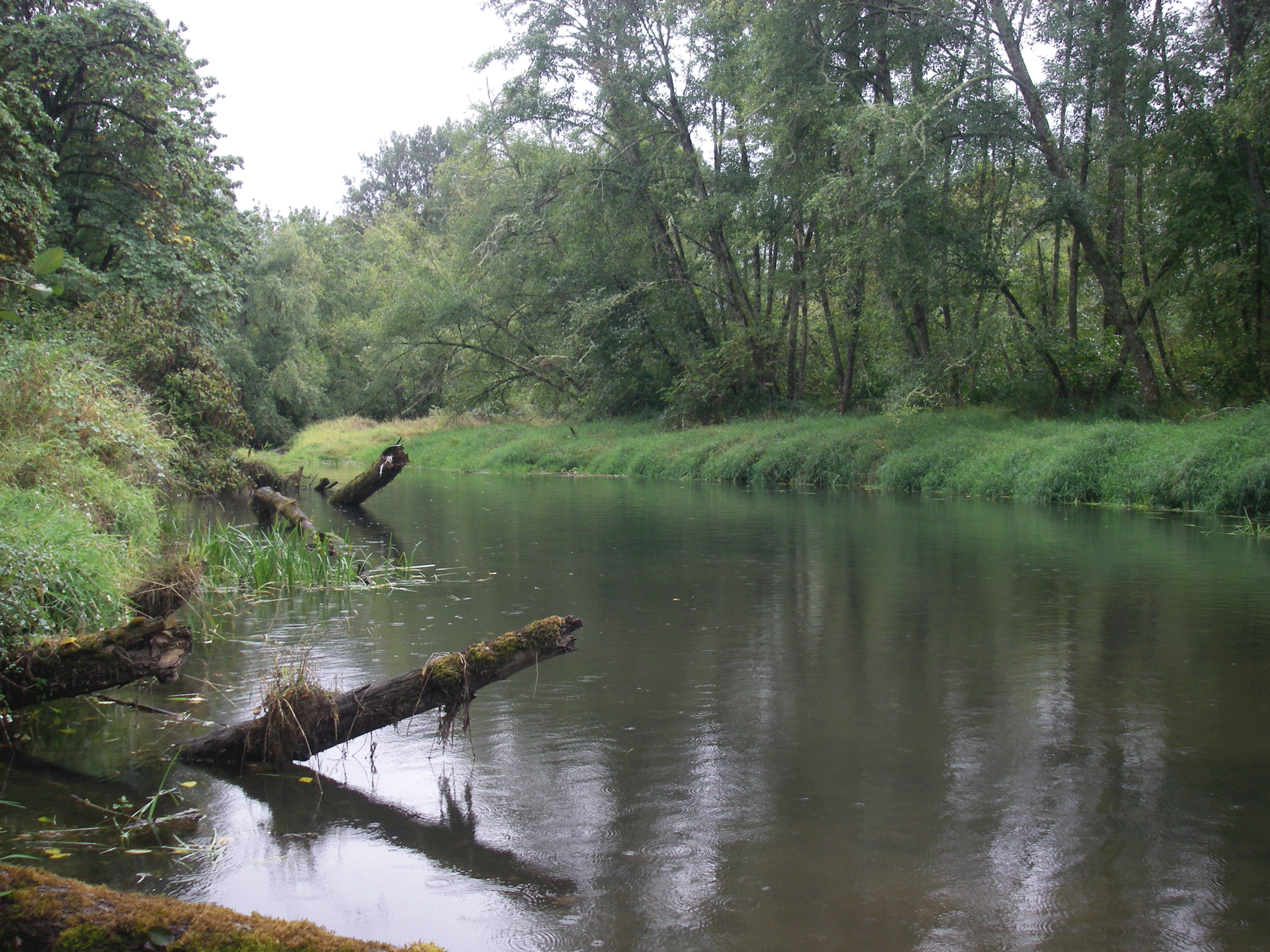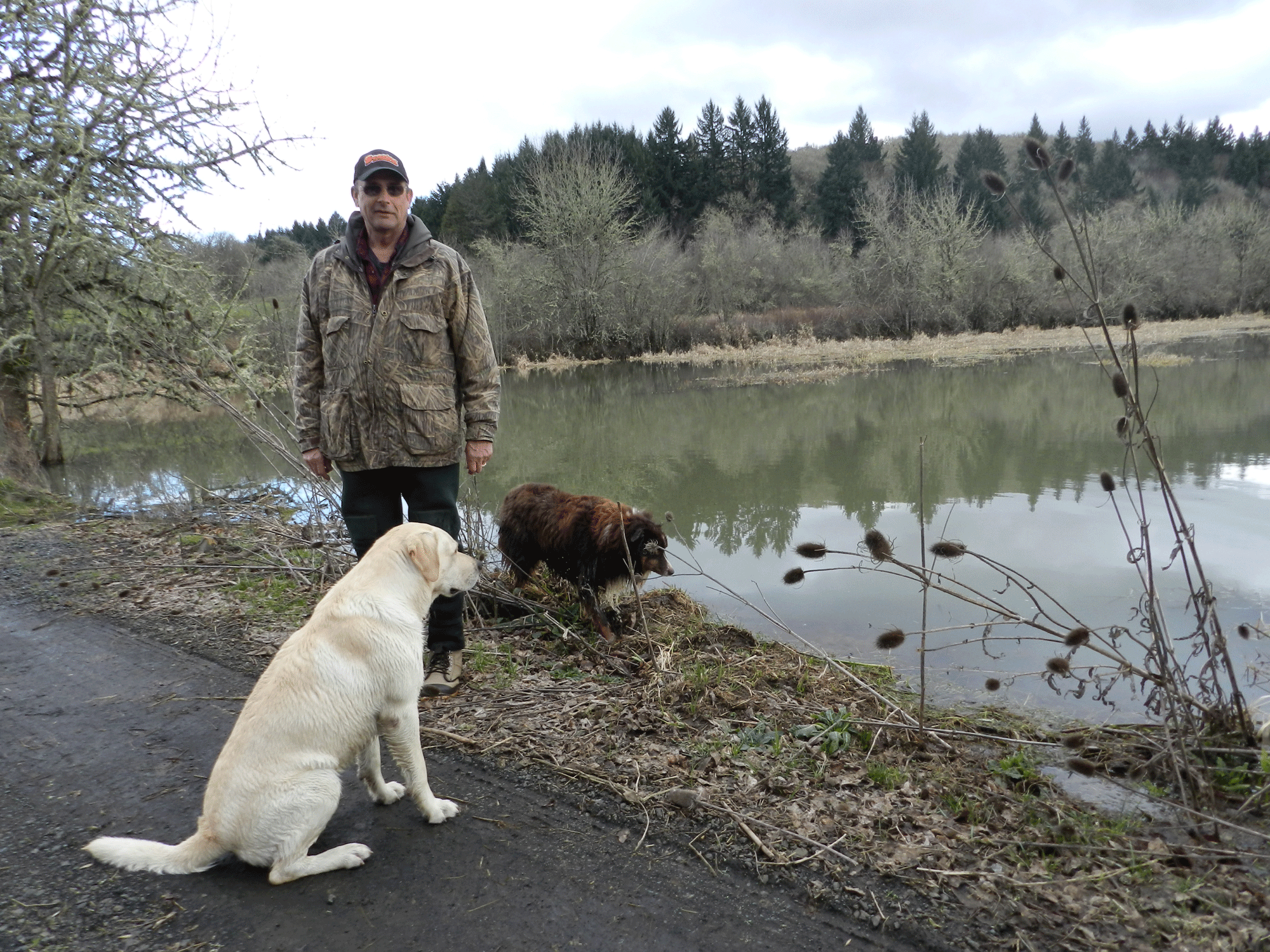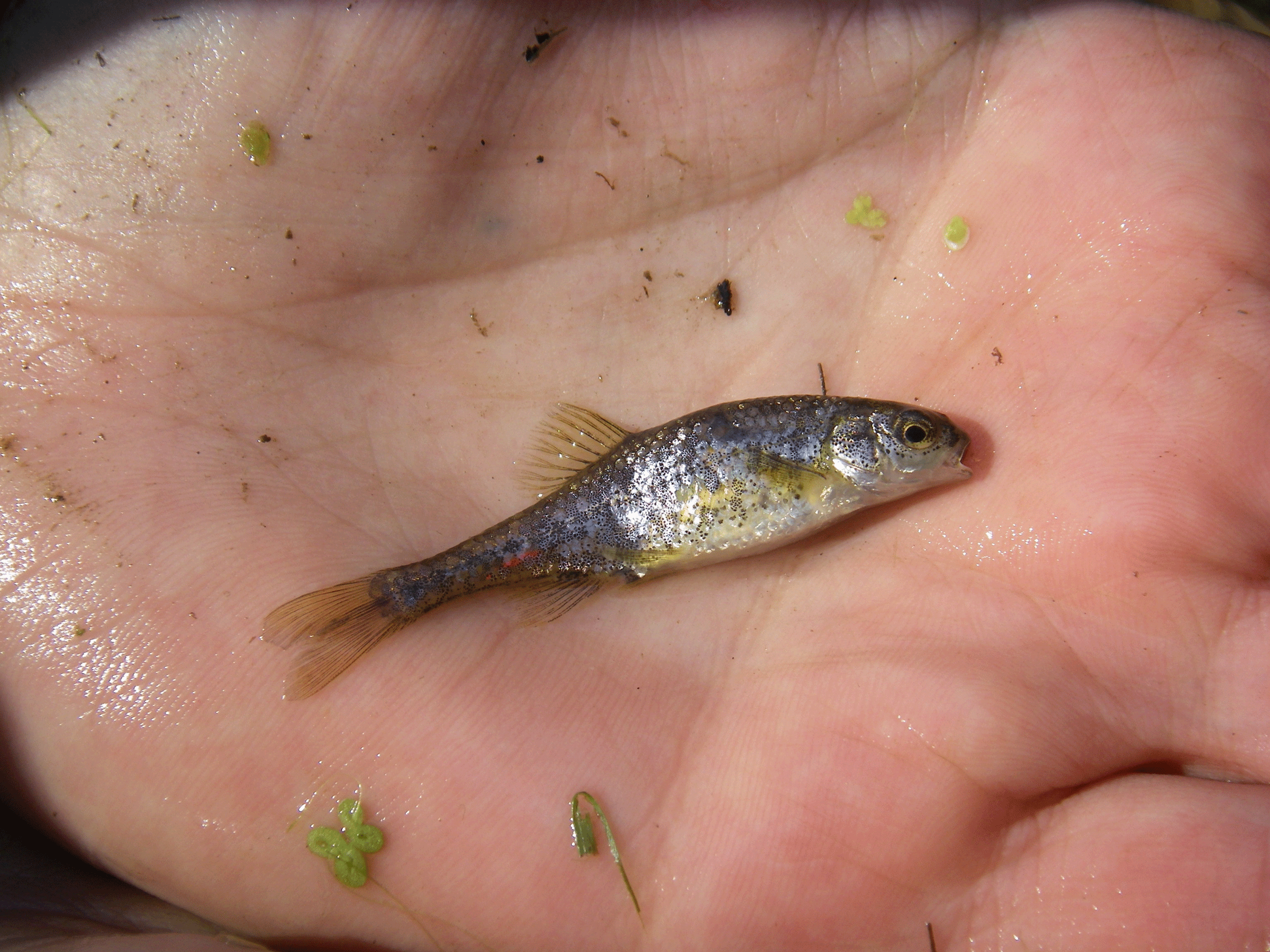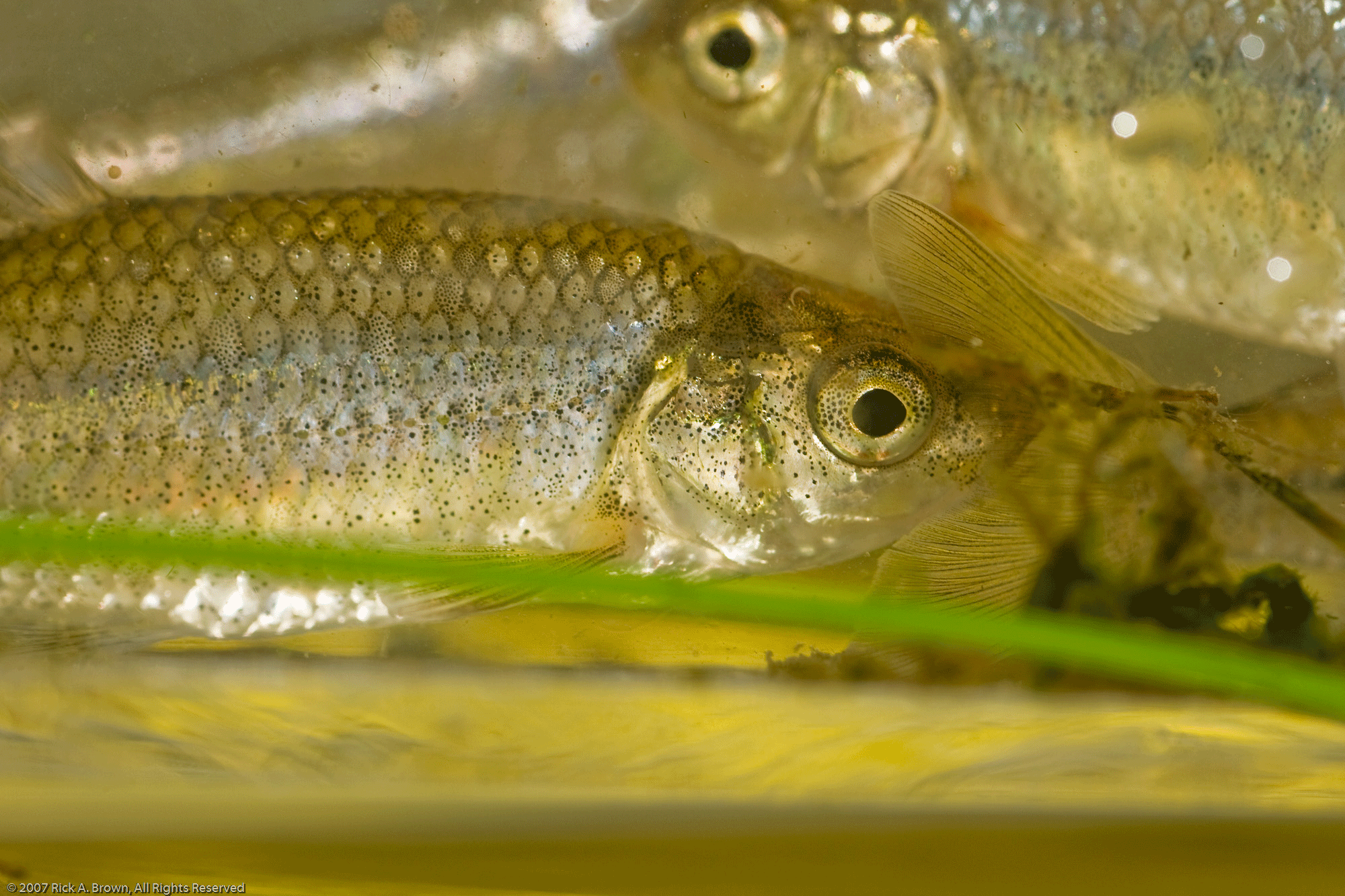Oregon Minnow Thriving and No Longer Endangered
Air Date: Week of February 28, 2014

A pair of Oregon chub from the Ankeny National Wildlife refuge (photo: Rick Brown)
A tiny minnow called the Oregon Chub was put on the Endangered Species List more than 20 years ago. But the Chub has rebounded, and now officials want to make it the first fish ever taken off the Endangered Species List because of population recovery.
Transcript
CURWOOD: Now our national symbol was once on the Endangered Species List, thanks to hunting, habitat loss and the pesticide DDT, but since DDT was banned in1972 the bald eagle recovered enough to be taken off the list in 2011. And now we have news of another possible delisting - a tiny minnow called the Oregon Chub. This little fish lives only in the Willamette Valley of Oregon and was first ruled endangered more than 20 years ago. The chub started to rebound, and by 2011 it was classified as merely threatened. Now officials are saying it’s fully recovered, and want it removed from Endangered Species List altogether, which would be a first for fishes. Cassandra Profita from the public media collaborative EarthFix has our story.
AUER: Hank! Come.
PROFITA: John Auer and his dog Hank are in the middle of his family's 900-acre farm near Monmouth.
After strapping on some waders, Auer pushes through thick tangles of grass and sinks into brown, swampy water.

Jon Auer with his dogs next to his chub pond (photo: Casandra Profita)
AUER: Home base for chub is inside here.
PROFITA: On about 30 acres of the farm, Auer has teamed up with wildlife managers to expand the marshlands around Jont Creek. They removed soil and replaced some invasive reed canary grass with native plants. Auer says the idea was to improve habitat for salmon, steelhead and waterfowl.
AUER: I go duck hunting out here twice a year, maybe. The rest of the time it's theirs. They can have it.
PROFITA: But in the process of sampling the fish in the new habitat, a biologist with Oregon Department of Fish and Wildlife found many other lesser-known species.
AUER: He just pulled these little crawdad traps up, and he caught like 250 fish – little fish of all different kinds that I didn't even know were in here.
PROFITA: In a pond behind a beaver dam, the traps revealed dozens of a native minnow called Oregon chub. This little fish – which grows no more than three inches long – has been on the endangered species list since 1993.
AUER: He told me they were a threatened species. I was taken aback. I had no idea they would be here or that there even was that kind of fish.

Brian Bangs holds an Oregon Chub in his hands (photo: Oregon Department of Fish and Wildlife)
PROFITA: Brian Bangs is the biologist who found the chub on Auer's property. He's been working to recover the species since 2005 – wading into Willamette Valley muck to look for them and at times getting stuck in the process. He says the fish can be a bit underwhelming in appearance.
BANGS: Yeah, they don't look like much, but they're representative of a lot of the habitat we used to have here in the valley – the swampy, lowland habitat that was prevalent in the bottom of the valley before colonization and industrialization.
PROFITA: Most people don't know about Oregon chub. They're certainly not a fish anglers try to catch. Though they do get eaten by a lot of game fish. And that was part of the problem.
BANGS: Bass, bluegill, crappie, bullhead. These were brought rover and introduced as sport fish. Oregon chub hide in vegetation, and this is the same spot where a lot of predators are hunting.
PROFITA: Biologists came up with a simple plan to keep the invasive fish from eating the minnows to the point of extinction: They introduced chub to predator-free ponds, where their numbers could grow.
That helped with another problem chub faced, which was the loss of ponds and sloughs. Bangs says the construction of dikes and dams to control flooding eliminated a lot of the marshlands chub like to call home.
BANGS: Chub like silty, muddy substrates – the kind of places where you say ‘I'm not drinking that water.’
PROFITA: Project leader Paul Scheerer has been working to recover chub since they were first listed. He says in a way, the fact that chub keep a low profile has helped them recover. It was painless for many landowners to add chub ponds without changing their farm forest operations.
SCHEERER: The fact that they're small and don't have a lot of effect on people made our job a little bit easier..
PROFITA: Meanwhile, efforts to improve salmon and steelhead habitat by allowing more water flows through dams on the Willamette River have also been helped the lesser-known chub. When the fish were listed as endangered, biologists could account for less than 1,000 Oregon chub. Now, there are around 160,000 of them. A large chunk of their new habitat is on private land like Auer's family farm.
SCHEERER: We have a little fish that most people didn't know about, few people care about and we've managed to recover them in a working landscape. I think it demonstration that it can be done.
PROFITA: Paul Henson is the state supervisor for the US Fish and Wildlife Service in Oregon. He says everyone agrees these little fish no longer needs endangered species protection.
HENSON: Oregon chub. It’s so clearly recovered now. I have not heard of anyone disagreeing with the decision here. I'd say it's pretty much a consensus that the time is right.

A pair of Oregon chub from the Ankeny National Wildlife refuge (photo: Rick Brown)
PROFITA: That's a big deal because while other fish have been removed from the endangered species list. It hasn't been because their populations rebounded. Take the long jaw cisco, blue pike and tecopa pupfish. They all came off the list – because they went extinct.
HENSON: Overall in the US we have 1400 species listed: Fish, plants, birds, insects. And there’s not yet been a fish yet proposed for delisting due to recovery.
PROFITA: A thriving population of Oregon chub isn't just good news for the future of these minnows. It's also one more step in making the Willamette Valley a healthier place for the native birds, reptiles and other fish that live in the same swamps -- and rely on the Oregon chub as part of their food chain.
PROFITA: That’s why John Auer says he’d be happy to add another chub pond on his family farm – whether the fish are endangered or not.
I’m Cassandra Profita reporting.
CURWOOD: There’s more about the Oregon chub and the public media collaborative EarthFix at our website, LOE.org.
Links
Living on Earth wants to hear from you!
Living on Earth
62 Calef Highway, Suite 212
Lee, NH 03861
Telephone: 617-287-4121
E-mail: comments@loe.org
Newsletter [Click here]
Donate to Living on Earth!
Living on Earth is an independent media program and relies entirely on contributions from listeners and institutions supporting public service. Please donate now to preserve an independent environmental voice.
NewsletterLiving on Earth offers a weekly delivery of the show's rundown to your mailbox. Sign up for our newsletter today!
 Sailors For The Sea: Be the change you want to sea.
Sailors For The Sea: Be the change you want to sea.
 The Grantham Foundation for the Protection of the Environment: Committed to protecting and improving the health of the global environment.
The Grantham Foundation for the Protection of the Environment: Committed to protecting and improving the health of the global environment.
 Contribute to Living on Earth and receive, as our gift to you, an archival print of one of Mark Seth Lender's extraordinary wildlife photographs. Follow the link to see Mark's current collection of photographs.
Contribute to Living on Earth and receive, as our gift to you, an archival print of one of Mark Seth Lender's extraordinary wildlife photographs. Follow the link to see Mark's current collection of photographs.
 Buy a signed copy of Mark Seth Lender's book Smeagull the Seagull & support Living on Earth
Buy a signed copy of Mark Seth Lender's book Smeagull the Seagull & support Living on Earth

